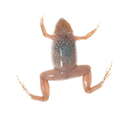ar
الأسماء في صفحات التنقل


Chiasmocleis royi, the reticulated humming frog, is a frog endemic to Bolivia, Brazil, and Peru. This frog often shares burrows with tarantulas in what may be a mutualistic or commensalistic symbiosis.[2][1][3]
Scientists have seen this frog emerging from the same burrows or holes in trees as tarantulas in the genus Pamphobeteus. Both species are nocturnal. The spiders eat other frogs but not reticulated humming frogs.[4][2]
Scientists think the tarantulas use pheromones to tell which frog is which. They have seen young tarantulas catch and pick up small reticulated humming frogs in the same posture as when catching frogs to eat. The tarantulas touch the reticulated humming frogs with their mouths and then put them back down without biting them.[4] Microhylid frogs, like the reticulated humming frog, make chemicals in their skin that taste bad. Scientists think this might be why the frogs and spiders started living together.[2]
Scientists do not know whether the reticulated humming frog and the tarantula both benefit or whether living with the tarantula is beneficial only to the frog. The frog lives in the tarantula burrow, where it is safe from drying out during the day and where frog-eating predators will not go. However, scientists have seen fly larvae on young tarantula spiderlings. The scientists speculated that this frog may help the tarantulas by eating flies that enter the burrow before they can lay eggs.[4]
Other frogs and tarantulas that live far from South America also live together like this. For example, there are frogs and tarantulas in Sri Lanka that live together this way. Scientists think this relationship evolved more than once.[2]
Chiasmocleis royi, the reticulated humming frog, is a frog endemic to Bolivia, Brazil, and Peru. This frog often shares burrows with tarantulas in what may be a mutualistic or commensalistic symbiosis.
Scientists have seen this frog emerging from the same burrows or holes in trees as tarantulas in the genus Pamphobeteus. Both species are nocturnal. The spiders eat other frogs but not reticulated humming frogs.
Scientists think the tarantulas use pheromones to tell which frog is which. They have seen young tarantulas catch and pick up small reticulated humming frogs in the same posture as when catching frogs to eat. The tarantulas touch the reticulated humming frogs with their mouths and then put them back down without biting them. Microhylid frogs, like the reticulated humming frog, make chemicals in their skin that taste bad. Scientists think this might be why the frogs and spiders started living together.
Scientists do not know whether the reticulated humming frog and the tarantula both benefit or whether living with the tarantula is beneficial only to the frog. The frog lives in the tarantula burrow, where it is safe from drying out during the day and where frog-eating predators will not go. However, scientists have seen fly larvae on young tarantula spiderlings. The scientists speculated that this frog may help the tarantulas by eating flies that enter the burrow before they can lay eggs.
Other frogs and tarantulas that live far from South America also live together like this. For example, there are frogs and tarantulas in Sri Lanka that live together this way. Scientists think this relationship evolved more than once.
Chiasmocleis royi[1] es una especie de anfibio anuro de la familia Microhylidae.[2][3][4]
Esta especie habita:
Las 24 muestras masculinas observadas en la descripción original miden de 18.8 mm a 23.1 mm y las 16 muestras femeninas observadas en la descripción original miden de 20.7 mm a 27.6 mm.
A veces, esta rana comparte madriguera con tarántulas del género Pamphobeteus. Los científicos han visto múltiples ranas y arañas, tanto adultas como jóvenes, saliendo de la misma madriguera para buscar comida. Generalmente, las ranas se alejan más de la madriguera que las arañas. No comparten actividades durante la noche.[6]
Científicos han visto tarántulas jóvenes atrapar y recoger pequeñas ranas en exactamente la misma manera que sus presas. Sin embargo, en lugar de morder, tocan la rana con la boca y luego la vuelven a poner ilesa. Se cree que los químicos en la piel de la rana le saben mal a la tarántula.[2][6]
Científicos no están seguros de si se trata de un caso de comensalismo o de mutualismo. La rana se beneficia de la relación porque puede esconderse de la luz del sol en una madriguera segura. Sin embargo, no está claro si la tarántula se beneficia. Se han visto larvas de moscas parásitas en crías de este tipo de tarántula, y es posible que las ranas maten a las moscas que se aventuran en la madriguera.[6]
Esta especie lleva el nombre en honor a Roy Wallace McDiarmid.
Chiasmocleis royi es una especie de anfibio anuro de la familia Microhylidae.
Chiasmocleis royi est une espèce d'amphibiens de la famille des Microhylidae[1].
Cette espèce se rencontre[1] :
Les 24 spécimens mâles observés lors de la description originale mesurent entre 18,8 mm et 23,1 mm et les 16 spécimens femelles observés lors de la description originale mesurent entre 20,7 mm et 27,6 mm[2].
Cette espèce est nommée en l'honneur de Roy Wallace McDiarmid[2].
Chiasmocleis royi est une espèce d'amphibiens de la famille des Microhylidae.
Chiasmocleis royi[1] é uma espécie de anfíbio da família Microhylidae. Pode ser encontrada no oeste do Brasil, norte da Bolívia e no leste e sul do Peru.[2]
Chiasmocleis royi é uma espécie de anfíbio da família Microhylidae. Pode ser encontrada no oeste do Brasil, norte da Bolívia e no leste e sul do Peru.